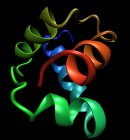

![]()
Protein Folding
Introduction
Proteins are the most versatile macromolecules in biological systems. They fulfill a multitude of different tasks from storing other molecules like oxygen in human blood to catalytic function. They are responsible for the stability of macro-complexes, such as hair, and facilitate membrane transport or the transmission of electric signals in the human brain. In spite of this importance their properties and function are still far from being fully understood by scientists. Their basic composition is that of linear polymers composed of sequences of amino acids. This amino acid sequence is encoded by DNA. It already contains all necessary information about the unique three-dimensional structure of a protein which is directly correlated to its function. The formation of this three-dimensional structure in their physiological environment, mostly water, out of its linear amino acid sequence takes place in a complex process called protein folding. Regardless of the starting point or de-folding it by changing the environmental conditions many proteins will finally always assume the same structure. Very few proteins show an alternative native state under minimal changes in environment like, for example, prions. This unique three-dimensional structure is called the native state of a protein which can be obtained to atomic resolution for many proteins by X-ray scattering or NMR. For lack of suitable experimental techniques, time resolved information on the the actual folding process is currently not available with similar detail. In order to theoretically understand the process of protein folding scientists in different fields, such as biology, information science, mathematics, biochemistry and physics, have pursued various often interdisciplinary approaches. Knowledge based approaches use databases of experimentally determined structural information for proteins to predict structures for other proteins. In recent years these methods have made steady progress towards de-novo protein structure prediction, although they require substantial sequence similarity to yield usable results. Unfortunately they give only indirect evidence regarding the mechanisms by which proteins assume their unique three-dimensional structure. The challenge for more sophisticated models motivated by physical ideas is the size and complexity of the system. Proteins consist of numerous different amino acids with hundreds of atoms but have no exploitable higher symmetries. In order to gain more insight into the folding process simple, but tractable lattice models representing protein structure have been developed. The necessary simplifications however leave a wide gap between these models and actual protein structure. The simulation of the protein folding process by molecular dynamics using existing biomolecular forcefields like AMBER or CHARMM has yielded increasingly valuable insights into the folding mechanisms. Such simulations permit the understanding of the folding process by an interpretation of the gained data, but are presently limited to very small proteins by the extremely high computational demands. One major source of complexity arises from the strong influence the environment has on the folding process and protein structure. Thus the appropriate inclusion of solvent effects has lead to controversial debates. It is also presently unclear which families of proteins are adequately folded using established forcefields with molecular dynamical simulations. In some simulations the forcefields fail to stabilize the native state.
My contribution to this field
In my PhD-thesis I investigated the validity of an alternative, atomically resolved approach to the folding of proteins. It is based on models of the underlying physical interactions. The thermodynamic hypothesis postulates that most proteins are in thermodynamic equilibrium with their environment. Therefore it should be possible to represent this unique native state as the global minimum of an appropriate free-energy model. I applied an all-atom free-energy-forcefield} based on physically motivated interactions called PFF01 to represent the underlying interactions governing protein structure formation. Starting from random initial conditions we predicted protein structure de-novo, by identifying the global optimum of the forcefield. The computational demands of this approach are significantly less than molecular dynamical simulations while still allowing insight into the forces responsible for stabilizing the native state or driving the folding process. We validated the forcefield against experimental data successfully, i.e. the experimentally determined native state corresponded to the global minimum of PFF01 by developing and testing new stochastic optimization schedules. Accordingly I could address two central questions of protein folding: Protein folding is ultimately governed by complicated quantum-mechanical effects, such as the formation of hydrogen bonds, Fermi-repulsion of electronic clouds and interaction of the protein surface with a complex environment: Can the folding of a protein be understood and represented by a classical free-energy-forcefield and, if yes, how can it be done in a computationally treatable way? Proteins have many degrees of freedom and no exploitable symmetries. It is known that global minimization of rough and high-dimensional energy landscapes, like those in spin-glass theory, is very difficult. Therefore: Due to the complexity of such a forcefield, are there optimization methods allowing to find the global minimum and what about the efficiency of these methods? Short answer (for more details I must refer to my publications): The found global minima for different proteins in PFF01, ranging from 20 to 60 amino-acids were in agreement with experimental data underlining that this approach can successfully address the problem of protein structure prediction. Therefore current day computational resources are able to both describe the native state of a protein as the global minimum of an appropriate free-energy forcefield and find it successfully on a reliable basis